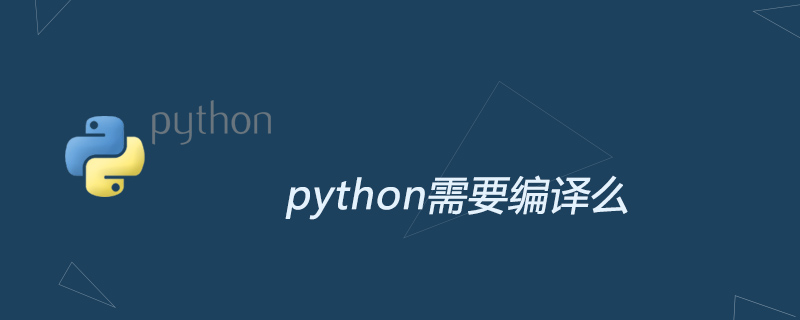Home >Backend Development >Python Tutorial >Does python need to be compiled?
Does python need to be compiled?
- 尚Original
- 2019-07-04 17:31:349538browse

A frequently heard question is: Is Python an interpreted language? Will it compile? This question is not as easy to answer as imagined. Like many people who understand the world, they are used to judging some things based on a simple model. In fact, it contains many, many details.
Generally speaking, compilation means converting a high-level language into machine code that can be executed by the CPU. When you compile C, this is exactly what you do. The result of compilation is a binary executable file, and your system can run this program directly.
In contrast, the explanation means this: when the program is running, it reads one line of code in the source file each time and performs the corresponding operation, repeating this line by line. Of course, this is how so-called scripting languages work.
But in fact, the above definition has too many limitations. A real language usually adopts various implementation methods in order to have more useful and powerful features. We can understand compilation as more general: converting one language into another language form. Generally speaking, the source language is more advanced than the target language, such as converting C into machine code. Of course, the conversion from JavaScript 8 to JavaScript 5 is also a kind of compilation.

In Python, source code is compiled into a lower-level form, which we call bytecode. Bytecode is a sequence of instructions, similar to a CPU's instruction set. But the bytecode is not executed directly by the CPU, but in the virtual machine. Of course, the virtual machine here does not imitate the entire operating system environment, but only provides an environment for bytecode execution.
Let’s look at a small piece of Python code and its corresponding bytecode

After reading the content of the bytecode, we know that f' ...' The operating principle of this formatted string form is to convert the string inside into a series of literal strings and variables, and then connect them using numbers.
dis is a disassembly module in the Python standard library, which can display the bytecode information of Python code. The virtual machine that executes bytecode mentioned above can be implemented in any language, including Python itself. If you are interested, you can check out this project nedbat/byterun on GitHub. This project can be used for learning, but is not suitable for production environments.
However, when we run Python, we cannot feel its compilation process at all. There is no display of what compiler is called. We just simply execute the .py file, and the compilation is automatically compiled when needed. This is different from JAVA. Every time you write JAVA code and want to execute it, you have to manually compile it into a .class file and then execute it. It is for this reason that JAVA is called a compiled language and Python is called an interpreted language. But in fact, both languages are first compiled into bytecode when executed, and then handed over to the virtual machine for execution.
Python also has an important feature, which is the interactive command line. You can type a line of Python statement and press Enter immediately to execute it. In fact, even in this process, Python is first converted into bytecode and then executed. This interactive command line feature is not available in many compiled languages. Also because there is no explicit call to the compiler, many people call the program that executes Python source files a Python interpreter.
Even though it is relatively simple, I still want to add it. Some compiled languages such as C or JAVA also have interactive command lines, but these are not the focus of these languages. JAVA was first compiled into bytecode and then executed. Later, with just-in-time compilation technology (JIT), it can be directly compiled into machine code, similar to C.
As can be seen from the above description, interpretation and compilation cannot be completely separated. Many times, we want to use some words to classify existing programming languages, but in fact it is too difficult to do this.
The last thing to note is that how your code is executed is only a matter of language implementation, not a feature of the language. Above, we are talking about Python, but it is actually a description of CPython. CPython is an interpreter, so called because the interpreter is written in C, which is also the default interpreter for Python. Of course, there are many other interpreters. For example, PyPy is another interpreter that uses JIT technology and its running speed is greatly improved compared to CPython.
Back to the question in the title, the reason why Python is called an interpreted language is because it does not explicitly call the compilation operation and shows more interpreted characteristics. But in fact, compilation exists. How to compile it depends on the implementation of the language, that is, the design of the interpreter.
For more Python related technical articles, please visit the Python Tutorial column to learn!
The above is the detailed content of Does python need to be compiled?. For more information, please follow other related articles on the PHP Chinese website!

